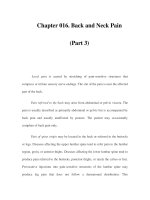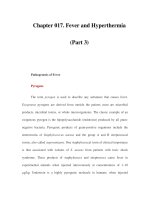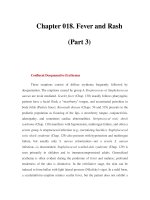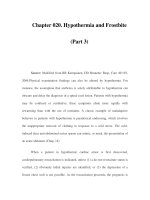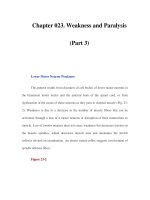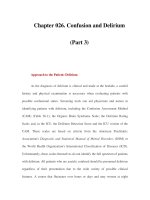Chapter 039. Nausea, Vomiting, and Indigestion (Part 3) ppsx
Bạn đang xem bản rút gọn của tài liệu. Xem và tải ngay bản đầy đủ của tài liệu tại đây (14.68 KB, 5 trang )
Chapter 039. Nausea, Vomiting,
and Indigestion
(Part 3)
Disordered gut sensorimotor function also commonly causes nausea and
vomiting. Gastroparesis is defined as a delay in emptying of food from the
stomach and occurs after vagotomy, with pancreatic adenocarcinoma, with
mesenteric vascular insufficiency, or in systemic diseases such as diabetes,
scleroderma, and amyloidosis. Idiopathic gastroparesis occurring in the absence of
systemic illness may follow a viral prodrome, suggesting an infectious etiology.
Intestinal pseudoobstruction is characterized by disrupted intestinal and colonic
motor activity and leads to retention of food residue and secretions, bacterial
overgrowth, nutrient malabsorption, and symptoms of nausea, vomiting, bloating,
pain, and altered defecation. Intestinal pseudoobstruction may be idiopathic or
inherited as a familial visceral myopathy or neuropathy, or it may result from
systemic disease or as a paraneoplastic complication of a malignancy such as
small cell lung carcinoma. Patients with gastroesophageal reflux may report
nausea and vomiting, as do some individuals with functional dyspepsia and
irritable bowel syndrome.
Three other functional disorders without organic abnormalities have been
characterized in adults. Chronic idiopathic nausea is defined as nausea without
vomiting occurring several times weekly, whereas functional vomiting is defined
as one or more vomiting episodes weekly in the absence of an eating disorder or
psychiatric disease. Cyclic vomiting syndrome is a rare disorder of unknown
etiology that produces periodic discrete episodes of relentless nausea and
vomiting. The syndrome shows a strong association with migraine headaches,
suggesting that some cases may be migraine variants. Cyclic vomiting is most
common in children, although adult cases have been described in association with
rapid gastric emptying and with chronic cannabis use.
Extraperitoneal Disorders
Myocardial infarction and congestive heart failure are cardiac causes of
nausea and vomiting. Postoperative emesis occurs after 25% of surgeries, most
commonly laparotomy and orthopedic surgery, and is more prevalent in women.
Increased intracranial pressure from tumors, bleeding, abscess, or obstruction to
cerebrospinal fluid outflow produces prominent vomiting with or without nausea.
Motion sickness, labyrinthitis, and Ménière's disease evoke symptoms via
labyrinthine pathways. Patients with psychiatric illnesses including anorexia
nervosa, bulimia nervosa, anxiety, and depression may report significant nausea
that may be associated with delayed gastric emptying.
Medications and Metabolic Disorders
Drugs evoke vomiting by action on the stomach (analgesics, erythromycin)
or area postrema (digoxin, opiates, anti-Parkinsonian drugs). Emetogenic agents
include antibiotics, cardiac antiarrhythmics, antihypertensives, oral
hypoglycemics, and contraceptives. Cancer chemotherapy causes vomiting that is
acute (within hours of administration), delayed (after 1 or more days), or
anticipatory. Acute emesis resulting from highly emetogenic agents such as
cisplatin is mediated by 5-HT
3
pathways, whereas delayed emesis is 5-HT
3
-
independent. Anticipatory nausea often responds better to anxiolytic therapy than
to antiemetics.
Several metabolic disorders elicit nausea and vomiting. Pregnancy is the
most prevalent endocrinologic cause of nausea, occurring in 70% of women in the
first trimester. Hyperemesis gravidarum is a severe form of nausea of pregnancy
which can produce significant fluid loss and electrolyte disturbances. Uremia,
ketoacidosis, and adrenal insufficiency, as well as parathyroid and thyroid disease,
are other metabolic causes of emesis.
Circulating toxins evoke symptoms via effects on the area postrema.
Endogenous toxins are generated in fulminant liver failure, whereas exogenous
enterotoxins may be produced by enteric bacterial infection. Ethanol intoxication
is a common toxic etiology of nausea and vomiting.
Approach to the Patient: Nausea and Vomiting
History and Physical Examination
The history helps define the etiology of unexplained nausea and vomiting.
Drugs, toxins, and gastrointestinal infections commonly cause acute symptoms,
whereas established illnesses evoke chronic complaints. Pyloric obstruction and
gastroparesis produce vomiting within 1 h of eating, whereas emesis from
intestinal obstruction occurs later. In severe cases of gastroparesis, the vomitus
may contain food residue ingested hours or days previously. Hematemesis raises
suspicion of an ulcer, malignancy, or Mallory-Weiss tear, whereas feculent emesis
is noted with distal intestinal or colonic obstruction. Bilious vomiting excludes
gastric obstruction, while emesis of undigested food is consistent with a Zenker's
diverticulum or achalasia. Relief of abdominal pain by emesis characterizes small-
bowel obstruction, whereas vomiting has no effect on pancreatitis or cholecystitis
pain. Pronounced weight loss raises concern about malignancy or obstruction.
Fevers suggest inflammation; an intracranial source is considered if there are
headaches or visual field changes. Vertigo or tinnitus indicates labyrinthine
disease.
The physical examination complements information obtained in the history.
Demonstration of orthostatic hypotension and reduced skin turgor indicate
intravascular fluid loss. Pulmonary abnormalities raise concern for aspiration of
vomitus. Abdominal auscultation may reveal absent bowel sounds with ileus.
High-pitched rushes suggest bowel obstruction, while a succussion splash upon
abrupt lateral movement of the patient is found with gastroparesis or pyloric
obstruction. Tenderness or involuntary guarding raises suspicion of inflammation,
whereas fecal blood suggests mucosal injury from ulcer, ischemia, or tumor.
Neurologic etiologies present with papilledema, visual field loss, or focal neural
abnormalities. Neoplasm is suggested by palpation of masses or adenopathy.


